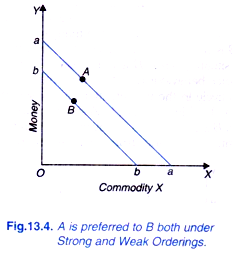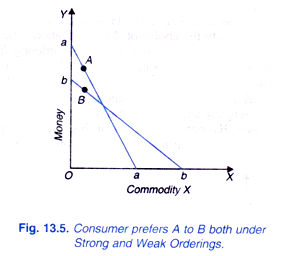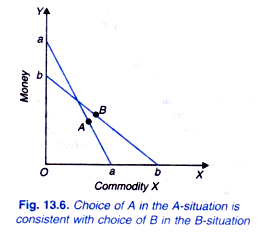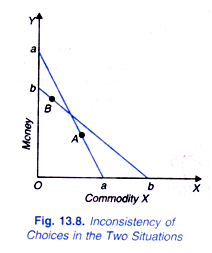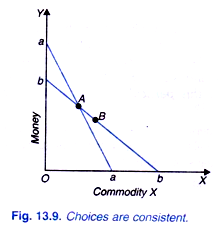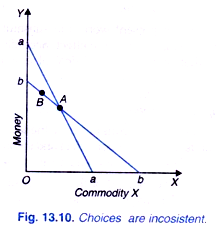Prof. Hicks assumes consistency of choice behaviour on the part of the ideal consumer whose scale of preferences remains unchanged when prices of goods and his income vary.
So, in order to derive laws about consumer’s demand. Hicks applies the consistency test which has been applied by Samuelson in his revealed preference approach.
Hicks calls this consistency test as the Direct Consistency Test. It should be remembered that the direct consistency is nothing else but the economic expression of the two-term consistency condition of the theory of the logic of order.
Consistency test, as applied by Samuelson, in his revealed preference theory is quite simple. But Hicks has elaborated the consistency idea by considering the consistency or inconsistency involved in numerous alternative cases. Consider Fig. 13.4 where commodity X is measured on the X-axis and the composite commodity, money (which represents all other commodities) on the Y-axis.
ADVERTISEMENTS:
The price of good X and income of the consumer being given, the alternative combinations which are open to the consumer are represented by the points within or on the triangle aOa. The point A on the line aa represents the actually chosen combination. Under strong ordering A is shown to be preferred to all other available combinations within or on the triangle.
But, under weak ordering, A is shown to be preferred to all the combinations within the triangle aOa and is either preferred or indifferent to other combinations on the line aa. Now, take another price-income situation bb in which price of good X is different, while the income of the consumer may or may not be different.
The various alternative combinations open to the consumer in the new situation are those lying within or on the triangle bOb. Point B on the line bb represents the actually selected combination in this new situation. Similar kind of preferences, as in situation A, will follow in situation B under strong and weak forms of preference hypothesis.
Since the consumer is assumed to be acting according to the unchanged scale of preferences in both situations, the preferences by him in the two situations must be consistent with each other. The consumer’s behaviour will be inconsistent if he reveals his preference for combination A over combination B in A situation, while in B situation he prefers combination B over combination when both the combinations A and B are available in both the situations. But, under weak ordering, the possibility of indifference has also to be taken into account.
The various possible cases in which consistency or otherwise has to be judged are the following:
(a)First, it is conceivable that one of the two price income lines lies wholly outside the other, as in Fig. 13.4, where aa lies wholly outside bb. In this case point B lies within the triangle aOa. Therefore, in the A situation, A is preferred to B both under strong and weak orderings. In the B situation, A is not available. Therefore, the consumer’s choice of A in the A situation is quite consistent with his choice of B in the B situation.
(b)Secondly, if one of the two price-income lines does not lie wholly outside the other, then the two will intersect each other at some point. Let us suppose that the price income line aa lies outside the price-income line bb on the left of the cross.
ADVERTISEMENTS:
When the two price-income lines intersects each other, then the following are the four possible cases:
(i) Both the selected positions A and B respectively in “the two situations lie to the left of cross, such as points A and B in Fig. 13.5. In this case, the choice of B in the B situation is quite consistent with the preference for A over B in the A situation. Position B lies within the triangle aOa and therefore the choice of in situation shows consumer’s preference for A over B, both under strong and weak orderings. But in the B situation A is not available, and therefore the choice of B in the B situation is quite consistent with the choice of A in the situation.
(ii) Both the selected positions A and B respectively in the two situations lie to the right of the cross as in Fig. 13.6. Here also the choice of B rather than A in B situation is quite consistent with the choice of Am A situation. The position A lies within the triangle bob and therefore under strong as well as weak ordering B is revealed to be preferred to A in the B situations. But the consumer chooses A in the A situation since B is not available in the A situation. Thus, in this case to the consumer’s choice behaviour is quite consistent.
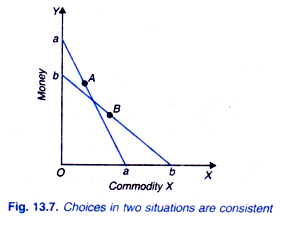
(iv) The two selected positions A and B respectively in the two situations lie inside the cross, A to the right and B to the left of it, as shown in Fig. 13.8. In this case, there is inconsistency. In the A situation when A is chosen, B lies within the triangle aoa, therefore A is revealed to be preferred to B. But in the B situation where A is also available and lies within the triangle bob, position B is chosen rather than A, showing consumer’s preference for B over A. Thus in this case, at one time the consumer prefers A to B and at another he prefers B to A. Hence his choice is quite inconsistent, both under weak ordering and strong ordering.
(c) Finally, we have a group of special cases when the two price-income lines intersect each other, but one of the two choice positions lies at the cross while the other chosen position may lie either outside or inside the cross. Thus, there are two possibilities in this respect.
(i) One chosen position A lies at the cross while the other one outside the cross. Suppose for instance chosen position A lies at the cross and chosen position B lies outside the cross as shown in Fig. 13.9. In this case, B is not available in the A situation. Therefore, the choice of A in A situation is not inconsistent. It should be noted that in the B-situation both A and B are present, B is actually chosen rather than A. Under weak ordering hypothesis it means that B is either preferred to A or indifferent to A (A also lies on the line bb). But in the A situation, the choice of A does not mean inconsistency since B is not available in the A situation.
ADVERTISEMENTS:
(ii) One chosen position lies at the cross, while the other one inside the cross. Suppose the selected position A lies at the cross and the selected position B inside the cross as shown in Fig. 13.10. In this case, position B lies within the triangle aOa. Therefore, the choice of A in the A situation shows, even under weak ordering, that A is preferred to B. But in the B situation the choice of B, under weak ordering, shows that either B is either preferred to A or B is indifferent to A (A also lies on the line bb) either of these is inconsistent with the definite preference for A over B. Hence if one chosen point lies at the cross, while the other inside the cross, there is inconsistency of choice in consumer’s behavior.
It is evident from the above analysis that we reach the same conclusion in all cases from the direct consistency test whether we are adopting strong or weak ordering hypothesis.
ADVERTISEMENTS:
On either hypothesis, there is inconsistency in the following two cases:
(i) When both positions A and B lie within the cross.
(ii)When one position lies at the cross and the other within the cross.
Though the weak and strong forms of preference hypothesis yield the same result in regard to the consistency tests but it should be remembered that the arguments by which they achieve the result are different. It may, however, be pointed out that the same identity or result under weak and strong orderings will not occur “when we proceed to generalise” (that is, when we take more commodities besides good X and composite commodity M and allow the price of more than one good to vary). But as long as we are limiting our analysis to the demand for a single commodity, we reach, the same conclusion in respect of the presence or absence of consistency whether we assume strong or weak ordering.
